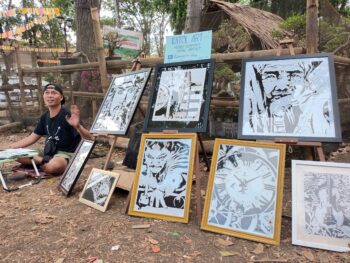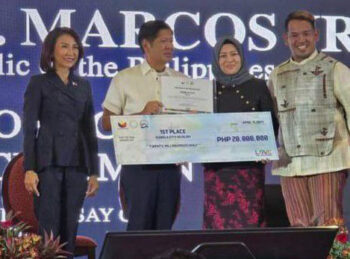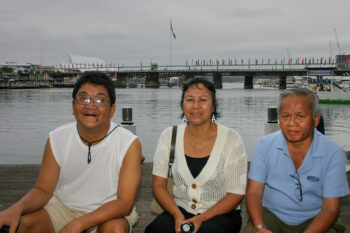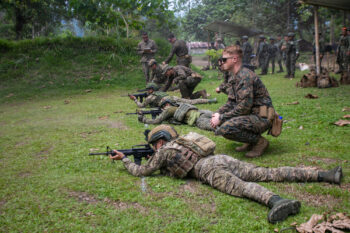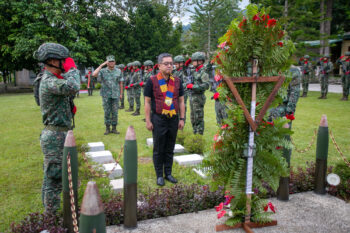DAVAO CITY (MindaNews/30 July) — Early this morning as I sat still in our chapel waiting for our community’s Morning Prayer session to begin, images of Jesuits I’ve met through the years – including the ones I met as a student in the then Ateneo de Davao College (1963-1967) and the ones I inter-act with these days – flooded my mind.
A few reasons explained this trekking down the memory lane. Yesterday, I was at Ateneo de Davao University’s (ADDU) Xavier Hall in the Community Center that now dominates Davao’s City’s skyline. Fr. Pat Riordan SJ of the Heythrop College of the University of London gave a lecture on Living In and With the Secular and there were a few Jesuits there, including ADDU’s President, Fr. Joel Tabora SJ.
Also… tomorrow is the feast of St. Ignatius and in the past week as I walked around the campus signs about this feast day have been posted all over. There is actually a close link between the Jesuits and the Redemptorists as the feast day of our own founder, St. Alphonsus, comes a day before St. Ignatius. This link has been strengthened with increasing collaborative efforts between ADDU and our own Institute (the St. Alphonsus Theological and Mission Institute or SATMI).
At the lecture there was a batch-mate who graduated at Ateneo in 1967 (Remy Guillena) and as we were seated together, we talked about how Ateneo was during our youth. And names of dear professors cropped up even as – today – we see their names on the walls of buildings named after them.
Man for others (these days this phrase has shifted to person for others in recognition of the political correctness of inclusive language) – these are the words that supposedly define the identity of the Ateneo graduate. But have we been persons for others? Are we?
Were the Jesuits themselves – especially the ones we met – persons for others, too? I speak for myself and my answer is this – by and large, Yes. Those of us who encountered the ones at the Ateneo in Davao (both Americans and Pinoys) in the 1960s were a lucky generation to have engaged the ones who were our teachers. Up till today, their faces in our minds remain sharp and when we reminisce about those good old days, memories of them bring smiles on our faces; occasionally, even tears in our eyes.
Jesuit vocations then were plentiful; there were close to twenty of them in the campus. Thus, they were very much part of our everyday experience in school. Only a Jesuit could teach Theology or religious studies then. And they were all over the place teaching English, Philosophy, Sociology, Anthropology, Psychology, Physics, Math and even Sports. They were advisers to various clubs and extra-curricular activities. We could even ask them for money to watch a movie in downtown San Pedro St.
As I was Prefect of both the Sodality of Our Lady and the Sanctuary Society, it meant having close ties with some of them. In my junior and senior year, almost every morning during the week, I had breakfast at the Jesuit residence having to make sure there were altar boys who served the Masses of the Jesuits. (Yes, the free breakfast did entice the student altar boys to wake up early to serve at the Masses). Then, each one of them said Mass in small cubicles in their residence, which has recently been demolished to give way to two new tall buildings in the campus. Earlier we had to memorize Latin Masses; by 1965, the liturgical language had shifted to English. In-between were a lot of confusions owing to the radical changes in liturgy.
The attraction to a Jesuit vocation naturally caught up with a few of us. I did apply to join them and was accepted. But after graduation in March 1967, the door to a Jesuit formation did not open for me and so I explored what the world had to offer a young man eager to spread his wings in the big metropolitan city of Manila. Fr. Federico O. Escaler, SJ, then Rector of Ateneo even wrote letters of recommendations on my behalf to heads of companies he knew in Manila.
It was heartbreaking to say goodbye to the Alma Mater because it meant leaving the Jesuit teachers behind as well as separating from close friends. When summers provided a time to come home, there was the attempt to say Hello to them; in time, however, they too were assigned elsewhere and were hard to reach. Further down the timeline, a few left this world and one visited them at the cemetery.
Interesting how some of them would re-appear in one’s life later on even as other Jesuits would enter one’s life. At the National Secretariat of Social Action, there was Fr. Carlos Abesamis, SJ, whose Third Look of Jesus would make such a major contribution to the rise of a social conscience among church workers during martial rule. A few other Jesuits were also involved in some of NASSA’s programs. Later on, as I returned to Davao there were Frs. John Montenegro and Ben Montecastro of the Mindanao Development Center who were very much part of the militant Church movement in the post-Vatican II era. (It has to be also noted that our circle did have tensions with a few other Jesuits caused by ideological differences; and as those at the Ateneo de Davao then were hampered by martial rule from taking a prophetic stance, our own links with the alma mater was practically nil. However, past is past and now as I have grown older, I am better able to understand and accept life’s realities).
When I met Fr. Escaler again in the late 1970s, he was already made a Bishop (first in Kidapawan and later in Ipil). I was elected then as Executive Secretary of the Mindanao-Sulu Pastoral Conference Secretariat (MSPCS) and he was Co-Chair of the Board to oversee the workings of the Secretariat. For three years, we worked very closely with each other even as I regularly visited him in Kidapawan. Mid-way through my term, the call to the religious life once more beckoned and I planned to resign from the post. When I consulted him about this, Bishop Escaler suggested that I go through an Ignatian discernment process so I could be sure what decision to make. I followed his advice and decided to postpone making up my mind about joining the religious life.
But I definitely was sure at that time that if I finally would opt for a religious life, I would not join the Jesuits. First because I knew that I didn’t want to end up assigned in a school; which meant that the main reason why I would become a religious – namely to be immersed among the poor and be of service to them in whatever way I could – may not happen. A few more years would pass before I finally took the leap to join the religious life; and it was to join the Congregation of the Most Holy Redeemer (or the Redemptorists).
Well, as our journey does not follow a straight line but instead a crooked one, the irony is that these days I am administrator of a school (as Dean of SATMI); although I hope this post will not last too long. But being in SATMI has brought me back to a closer collaboration with the Jesuits and my old alma mater. These days I find myself very much present in the campus of Ateneo, both in terms of following up students who are doing the Theology course, as well as teaching Anthropology. I join many other activities in the campus as ADDU – through the leadership of Fr. Tabora – is reaching out to the various social and ecological issues impacting the lives of not just the people in Davao, but throughout Mindanao. Our links with the Jesuits have expanded and deepened as we inter-act with the other Ateneos in Mindanao and met other Jesuits in various circumstances.
St. Ignatius and St. Alphonsus. Two different saints of two different eras and circumstances, but one in their desire to keep the Gospel alive, especially among their followers. One can only hope and pray that their descendants will heed the call of Pope Francis to be “experts in communion”. [Redemptorist Brother Karl Gaspar of Davao City, Academic Dean of the Redemptorists’ St. Alphonsus Theological and Mission Institute (SATMI), and author of several books, including the recently launched “Desperately Seeking God’s Saving Action: Yolanda Survivors’ Hope Beyond Heartbreaking Lamentations,” writes two columns for MindaNews, one in English (A Sojourner’s Views) and the other in Binisaya (Panaw-Lantaw)].



